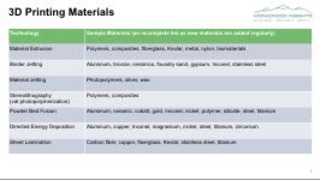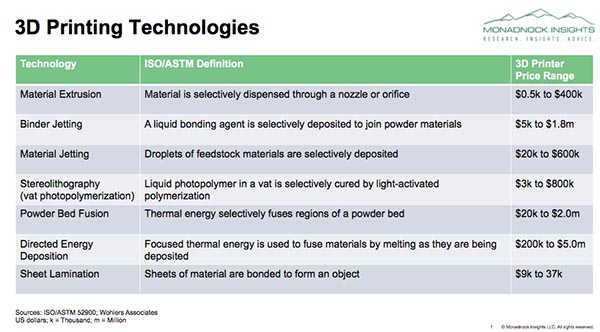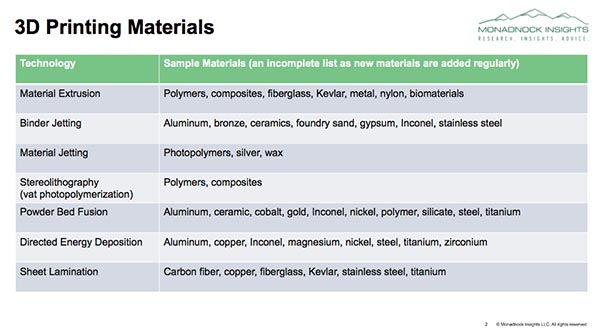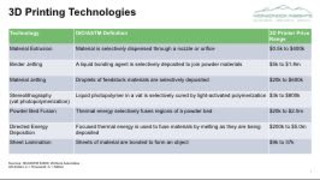3D Printing: Seven Technologies and a Multitude of Materials
“One word: ‘Plastics.’” This piece of advice for Dustin Hoffman’s character in the classic 1967 movie "The Graduate" defined a generation. But plastics do not define 3D printing.

“One word: ‘Plastics.’” This piece of advice for Dustin Hoffman’s character in the classic 1967 movie "The Graduate" defined a generation. But plastics do not define 3D printing.
Today, more than 30 years since the invention of 3D printing, metals, alloys, composites, and biomaterials are used by companies worldwide to make everything from prototypes to finished goods. And that includes vendors and printing companies in the 2D printing industry.
Quadpack, a global manufacturer and provider of hybrid packaging solutions for beauty brands headquartered in Barcelona, Spain, has upgraded its operations to include a Stratasys J850. The J850 supports its efforts to make prototypes with life-like realism. Current applications include prototype models to test new ideas for its Q-Line range of beauty packaging solutions and supporting its clients’ custom work. According to Quadpack, the benefits to it and its clients include “the J850’s unique full-color, multi-material capabilities (that) give us unparalleled ability to quickly and easily trial new concepts and ideas, while also expediting the initial design and development phase.”
In a case of using 3D printers to make 3D printer components, HP uses more than 100 3D-printed nylon parts in its 3D printers. For one part, HP’s and Siemen’s engineers redesigned a cooling tube for a 20% increase in performance. And HP’s Metal Jet 3D printer that produces metal parts is expected to become commercially available in the second half 2020 with broad availability expected in 2021.
Yet many people still think all 3D-printed parts are single-color plastic bits. Nothing could be further from reality.
3D printing is not one technology, no more than 2D printing is one technology. Interestingly, two of the seven 3D printing technologies are variations on the inkjet technology you are familiar with (and that includes the Stratasys J850). And just as 2D printers and presses range from $100 sheetfed desktop devices to multimillion-dollar web presses, so does the cost of 3D printers range from a few hundred dollars to a few million.
3D Printing Defined
3D printing is the additive process of joining materials to create objects based on digital models. The joining typically occurs layer by layer, adding one layer on top of the other, in a continuous process. Many engineers and other people say that “additive manufacturing” is a more accurate term but laypeople and the general media know it as “3D printing.” 3D printing’s definitional analogy is to screen printing: although silk is rarely used to make screens today, many people and printing industry professionals still refer to the process as “silkscreen printing.”
The process of joining materials employs one of the seven technologies while using one or more of a growing range of 3D-printable materials. The objects that are created range from prototypes to production aids to finished goods. But first, a digital model is created, typically using computer-aided design (CAD) software, but could involve other sources such as CT scans. The digital file is sent to the 3D printer and modified for printing, much like what happens within the raster image processer (RIP) used by a 2D printer.
3D Printing Technologies
ISO/ASTM defines the currently available technologies as shown below:

Material extrusion and stereolithography are the two original technologies, invented by Scott Crump and Chuck Hull, respectively, more than 30 years ago. Indeed, stereolithography (sometimes shortened to SL or SLA) is a trade name belonging to the company Mr. Hull founded, 3D Systems.
As you can see from the price range, material extrusion is used in consumer and industrial 3D printing. The idea of consumers making things with material extrusion 3D printers was at the core of the hype around 3D printing a decade ago. While some hobbyists may use stereolithography, for the most part the low-priced devices are used in an office environment where prototypes are made.
In any case, the ability to not only prototype parts but to also make production aids such as tooling, jigs, and fixtures makes material extrusion and SLA well-suited to uses within their operations by printing companies. At one point in my career, I was an engineering manager at New England Business Service (NEBS, later acquired by Deluxe). We designed and built our own printing presses—and modified commercially-available equipment from the likes of Heidelberg and Kirk-Rudy—with an in-house machine shop. Today, proprietary modifications to printing equipment (and the resulting competitive edge that you gain) can be produced with 3D printers.
Binder and material jetting are, as their names imply, based on jetting technology, just like your personal printer or production press. Binder printers jet a fluid that literally binds powders ranging from plastic to foundry sand. Material jetting emits plastics (or cellular materials) to build the part. When you consider uses ranging from the printing of 2D substrates and to imaging onto physical objects to producing 3D-printed items to bioprinting, I submit that jetting technology has the greatest upside potential of any imaging technology.
When people think of 3D printing metal, they often picture powder bed fusion printers. These devices use either lasers or electron beams as the energy source to fuse the raw powder material into a 3D object. While accurate, the presumption that powder bed fusion is only for metal printing is not—polymers are also used, although not in the same machine that 3D prints metal.
On the other hand, directed energy deposition (DED) can only print metals, generally a stream of powder that is lased at the point where the layer is being built. A unique characteristic of DED is its ability to be used as a selectable tool within a CNC machine, enabling both additive printing and subtractive processes such as machining, drilling, and polishing all in one operation. DED can be used to repair metal parts, for example, by adding material onto a worn part such as a component of a high-speed web press, that reduces maintenance costs.
Sheet lamination at one point included not only the ultrasonic welding of exotic metals and non-wovens but also (in a radically different process), laminating basic office paper. However, Mcor Technologies has gone into receivership, putting the future of its paper 3D printing process in doubt.
Bear in mind that while there are seven technologies currently acknowledged by ISO/ASTM, many if not most 3D printer technology providers say they have unique technologies. Those claims would have to be validated on a case-by-case basis but, fundamentally, commercially available 3D printers have these seven technologies at their core.
3D Printing Materials
The number of 3D-printable materials is a small fraction of all of the plastics, composites, alloys and metals used worldwide. Nevertheless, 3D printers use a wide—and growing—range of common, precious and exotic materials:

Certainly polymers, composites, carbon fiber, and other materials can benefit your operation.
The idea that 3D printing is about “One word: ‘Plastics’” is clearly erroneous. And when you consider the different technologies, price points, materials, and capabilities. then you can see how 3D printing will benefit your business.

